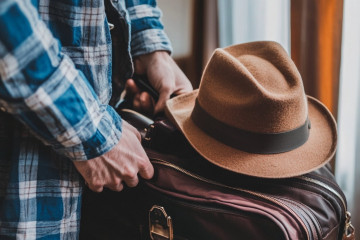Here’s what you need to know about every airline’s cleanliness dilemma.
Frequent fliers are familiar with the many ways your body changes while in a pressurized tube at 40,000 feet: Your ears pop, your ability to taste shifts, and you may find it harder to put your shoes back on after flying. And while there are some tricks to help you combat that last problem — start with a good pair of compression socks, for one — the best advice may be just to keep your shoes on the whole time.
It turns out the real reasons you should do this have more to do with avoiding some seriously icky situations than keeping your feet cozy. Here’s the truth about every airline’s cleanliness dilemma, and how being barefoot could even keep you from flying in the first place.
Planes aren’t cleaned as often as you think.
Generally speaking, airplane cabins are not very clean — although, for what it’s worth, the air very much is.
“Cabins are cleaned prior to every flight, but that will be more perfunctory on a quick turn when there are only 15 or 20 minutes to get it done,” says pilot Patrick Smith, author of “Ask the Pilot: Everything You Need to Know About Air Travel.”
That means what counts as cleaning the cabin could be as meager as tossing out the trash left behind in the seatback pockets and quickly wiping down high-touch surfaces like lavatory door handles. The reality is planes do go through deep cleaning, but not very often — the actual frequency varies by airline, but in general, this usually happens once every four to six weeks.
Otherwise, an airplane’s carpets are typically only vacuumed if time allows and spot-cleaned when necessary. In other words, whenever something — like food, a drink, or a type of bodily fluid — is spilled, the cleaning crew will eliminate the stain, but won’t necessarily disinfect the entire area, which could allow germs to spread.
“Those who decide to go barefoot might be picking up bacteria and viruses that could negatively impact their health,” says David Krause, the former owner of a business that manufactured cleaning products used on airplanes. “Likewise, the concern of picking up a fungal infection is always there as well.”
Oh, and while we’re discussing germs, the tray tables and armrests are absolutely filthy. Tray tables are one of the dirtiest parts of the plane — in addition to the bathroom handles, seat covers, overhead bins, and instruction cards — so put those alcohol wipes to good use and disinfect your space as soon as you board.
Flight attendants aren’t required to clean the restroom, just tidy it up.
Germaphobes everywhere, brace yourselves for this next part. You know those liquids on the floor in the lavatory? Flight attendants are not necessarily required to clean them up mid-flight, which means you could be stepping in urine.
Fortunately, airplane cleaning routines seem to have improved as a result of the Covid-19 pandemic, Krause says, adding that more disinfectants are being used to help prevent the spread of the virus. The real question is whether or not they’ve stayed that way.
According to an article by The Washington Post, staff shortages during and after the height of the pandemic have contributed to cleaning regimens becoming less thorough, as have changes in virus prevention protocol. Only time will tell if another outbreak results in cleanliness measures becoming more strict.
Being barefoot could get you kicked off the plane.
While airlines in general seem to have pretty standard dress code guidelines, being barefoot comes up in the contract of carriage when you agree to fly with a given carrier. The idea of “no shoes, no service” is actually quite prevalent in the terms and conditions of American Airlines, Delta Air Lines, United Airlines, Spirit Airlines, JetBlue, Alaska Airlines, and Hawaiian Airlines, and may keep you from flying at all.
Besides preventing a potentially smelly and unhygienic situation for everyone else on board, airlines need passengers to wear shoes for safety reasons, namely so they have their feet covered in the event of an emergency.
If anything, save your most comfortable footwear for your next flight or invest in some flight attendant-approved travel shoes. And whatever you do — out of courtesy for everyone else who sits there after you — don’t put your feet up on the tray tables or armrests. We’re all in this together. And come on, that’s just gross.



